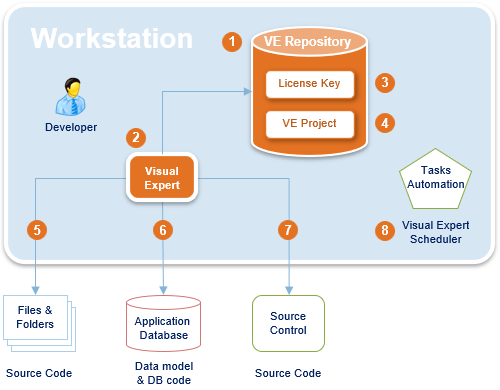IS THIS TUTORIAL FOR YOU?
Visual Expert can be installed in various configurations to meet your needs.
Depending on your volume of code and the size of your team, you will fall into one of the following cases:
- Trial with a small volume of code
No need for a tutorial.
Just install and follow the VE wizard. It will guide you and configure everything automatically. - Trial or Production for a single user, with mid-sized projects
If that’s your case, follow the guide below for Standalone configuration. - For all other cases (Multi User and/or Large Volume of code)
Follow this guide to install Visual Expert in a Client/Server configuration.
Follow this guide to install Visual Expert Web
Steps for Standalone Configuration
- Install SQL Server or use an existing instance.
- Install Visual Expert on a Workstation.
- Create a VE Repository and activate it with a Key.
- Create a VE Project and select the code to analyze:
A Select files or folders containing your code.
B Extract data model and code from your DB.
C Connect to a Source Control and fetch your code. - Schedule tasks: Code Analysis, document generation, and so on.

Step 1 – Install a new SQL Server instance, or use an existing one.
This instance will host the Visual Expert Repository.
Any version of SQL Server could be used, except for Express Edition or Local DB, which do not leverage all the RAM and CPU available on the machine.
If you don't have a SQL Server license available, you can install SQL Server Developer Edition – free of charge – since it will be used in the context of your development activities, and not for running an application in production.
Go further:
Step 2 – Install a Visual Expert copy on the workstation.
Download and install Visual Expert from this page.
Step 3 – Create a Repository, get a License Key
After the Visual Expert installation, a wizard will guide you to:
- Connect to the SQL Server instance prepared in Step 1.
- Create a Visual Expert Repository.
- Request a License Key.
Once generated, you will receive a notification.
Follow the instructions to download and install the key in the VE Repository.
Go further:
Step 4 – Create a Visual Expert project
This primarily consists in selecting the code & database(s) you wish to analyze.
Several options are available. You can combine them in a single project:
- Option A – You can select files and folders containing source code,
- Option B – You can connect to the application database(s), to extract and read stored procedures, functions, and a description of the data model.
- Option C – You can connect to a source control, to fetch and read source code.
Once the code selection is completed, the analysis will start.
A Window will show the analysis progress, and potential warnings.
Go further:
Step 5 – Automate Recurring Tasks
It is strongly recommended to schedule the code analysis, to refresh it automatically and take into account the recent code changes. Developers will then see the latest version of the code when they use Visual Expert.
You can also automate code inspection or documentation generation. In particular, this fits well with continuous integration and continuous delivery processes.
Go further:
